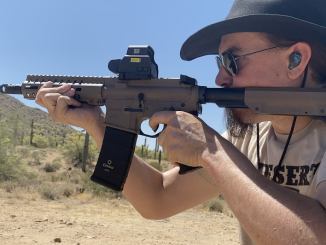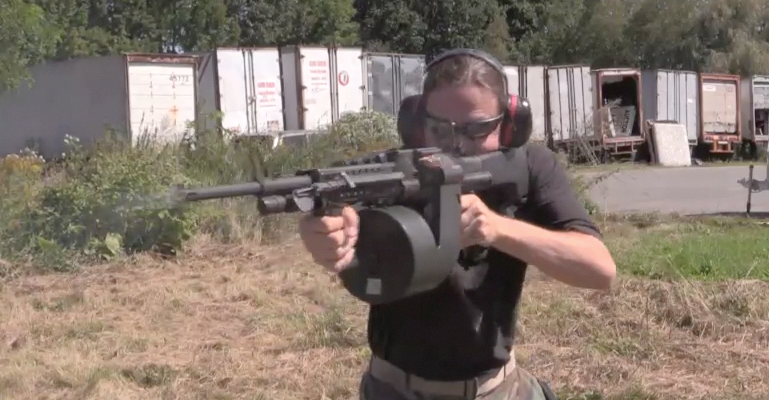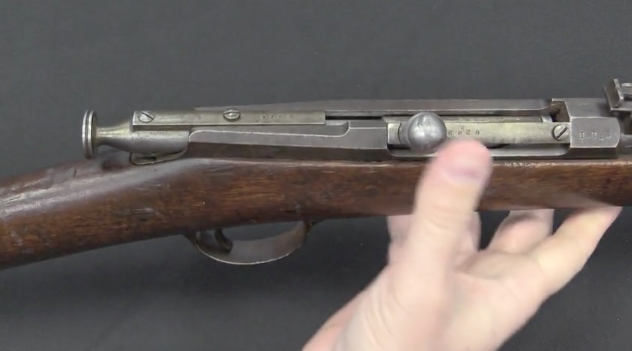The United States first experimented with a combination trowel and bayonet in 1868, producing 200 experimental examples made from standard socket bayonets. This was immediately followed by an additional 500 Model 1869 trowel bayonets made new. These were distributed to a few companies of the infantry to test in the field. Remarkably, the trials reports were overwhelmingly positive.
The US infantryman at that time did not carry any sort of entrenching tool, and so even an awkward combination tool was an improvement over a canteen cup or other ad hoc tool for digging. The bayonet was seen by some officers as becoming obsolete with the introduction of breechloading rifles, so the reduced effectiveness of the new item as a bayonet was not a substantial concern. The intended use of these tools was not to dig elaborate trenches, but rather to hastily construct a shallow ditch and embankment which would provide just enough cover to shelter a prone soldier.
With the trials reports in, the government purchased 10,000 of the improved 1873 pattern trowel bayonet, which featured a stronger blade and a much more comfortable handle for digging. These were issued and used in the field (and in several combat engagements), but the developmental direction turned towards combination knife trowels instead of bayonets, and there would be no further development or issue of these tools after the 1870s.




A poor fighting tool and a poor digging tool. Glad our doughboys didn’t show up in France with these!
With the edges sharpened it could be quite nasty…
It is argued that shovels with properly forged heads and sharpened edges killed more people than bayonets did during the Great War. At least the trowel bayonet was more useful than the spike. A proper entrenchment tool would have been better for digging. A proper knife would be better for utility and for getting rid of enemy sentries without raising the alarm.
It’s difficult to say which melee weapon killed the most. Sharpened shovels were more compact than a typical rifle and bayonet combination and could be used for hacking, which them better in the trenches. Different spikes (essentially daggers) and bludgeons seem to have been quite popular as well. They never replaced most of the bayonets, though.
Leave enemy sentries to Rambo,
99% of usual soldiers will never stumble on one, especially not in the ww1 mass infantry charges battlefield.
This device reminded me about World War I-era Canadian MacAdam Shield-Shovel
http://www.canadaatwar.ca/forums/showthread.php?t=2850
which was combination of shield and shovel. In both roles it performed poorly – using shovel with hole for digging seems unreasonable for me, as shield it was too weak and can’t stop incoming enemy fire.
To its credit, MacAdam shovel mimicked sniper-plates issued to trench soldiers. Too bad it was too thin to stop 8mm Mauser bullets. A few Canadian snipers stacked McAdam shovels to supplement protection.
Its shovel function was based on the dimensions of a shovel already in service. That shovel may have been big enough for a quick slit trench, but was not up to the task of excavating trenches for days on end.
During WW2, Canadian soldiers were issued mattocks, but picked up full-sized (metre long) shovels every chance they got. Kangaroo crews complained of infantry stealing tools off the back of their APCs.
Everyone agrees that General Sam Hughes was not the best supply officer supplied to the Canadian Army.
Shovel with hole in it works just fine on some types of soil, not much worse than normal shovel (even pitchfork with 6-8 spikes works on local soil and it is easier to drive it in than any shovel!). But for sandy soil this kind of tool looks unreasonable.
Not sure if MacAdam’s shovel can act as good shield.
I remember stories about guys using entrenching tool as hand-to-hand weapon in second Chechen war (1999-2000, with some terrorist activity up to 2009), some people still training to use it in combat.
“training to use it in combat”
Standard Imperial-Russian/Soviet/Russian shovel was and is МПЛ-50 with last number indicating overall length of 50 cm. This shovel was patented in 1870 by Mads Johan Buch Linnemann and despite various attempt of modernization it remain basically unchanged up to modern day. It is so balanced that can be thrown at enemy, see videos:
https://www.youtube.com/watch?v=mhQYKWqkXJY#t=4m
or
https://www.youtube.com/watch?v=ilLgZ84v01I
I own a few different e-tools from several different countries. The Russian is by far the most effective either digging or hacking things up. Sharpens up easy with a file( sharp enough to cut paper) and makes short work of thick tree roots. They are one nasty tool.
Carrots and potatoes stand no chance against the army carrying this.
I pity the gopher unlucky enough to be at the soldier’s mercy after failing to escape the garden…
During the American Civil War there were also experiments with adze-type bayonets;
https://i.pinimg.com/originals/38/bc/97/38bc9706a93f99b6304ef8d31366af62.jpg
They foundered on the same rock that wrecked the trowel bayonet. That being that a rifle-musket simply wasn’t built to cope with the torsional and rotational forces needed to be used as a shovel and/or pick handle. In fact, things tended to bend and even break- like the stock.
There were even later experiments with trowel bayonets. In Mexico, the Mondragon Model 1908 rifle came equipped with a trowel bayonet in the early 20th century;
https://i1.wp.com/mondragonrifle.com/wp-content/uploads/2017/04/bayonets-2.jpg?resize=842%2C582&ssl=1
Note that the blade center section housed a three-piece cleaning rod similar in concept to the Mauser 98 rod. And that the blade is stamped MADERA (wood) and HIERRO (iron), for reasons never mentioned in any Ejército de la República Mexicana training manual.
No, I don’t know why, either.
cheers
eon
“why”
According to https://www.google.com/patents/US1003119
Each edge of the blade a may be given a temper suitable for a specific purpose which may if desired be marked on the blade; for example, the inscriptions Iron and Wood on the edges might indicate that one of the said edges is more suitable for cutting metal wires or the like and the other edge for cutting wood.
This imply that MADERA mean cut wood using that side and HIERRO mean cut iron [wire] using that side
Why?
Because you never know what’s going to sneak up on you while you’re gardening.
OK, I get it: on the rifle, you basically have a version of the pole-arm called a spontoon (a wide-bladed spear, typically with a crossbar.) As a hand-held implement, you could indeed dig out a shallow fighting position quickly.
Nice.
The wide, leaf-shaped spearhead was also common in North Africa, often identified as ‘Sudanese’, although it wasn’t limited to Sudan. The African ones do not have the crossbar.
The purpose of the wide head is somewhat disputed. Some say it was just for intimidation, but others claim that it could be used to deliver cuts somewhat like a glaive. What is certain is that such a wide head is more likely to cut through major blood vessels than a more common narrow spearhead.
At least in artillery lingo, the muzzle plug is a ‘tompion.’ And yes, the word has the same roots.
Given a choice of “last ditch” weapons, which would you grab up in a muddy no-man’s land hand-to-hand scuffle outside the trenches?
1. Springfield 1888 with rod bayonet (and a live round in the chamber!!!)
2. MPL-50 shovel
3. Mondragon trowel bayonet
4. A crate full of stick grenades
5. Broad-ax
6. Luftwaffe M30 Drilling (who the heck dropped this!?)
7. MP-43/1 with a full magazine
8. Unique Model 17 pistol
9. US Model 1917 bayonet (in hand, not on rifle)
10. Grab something else from a dead guy!!
This is totally voluntary, by the way. Don’t feel pressured to answer.
Cherndog
“8. Unique Model 17 pistol”
Automatic pistol seems reasonable, if enough reliability is provided.
I’d love to see someone shoot offhand with one of these fixed. It looks like the largest gas trap ever.
it also sounds like the trowel is what got the knife and bayonet to hook up and become the modern knife bayonet.
This trowel bayonet look like the spears Shaka’s Zulu warriors used to wipe out a British Army at Isandhlwana, and which came close to victory at Rorke’s Drift a few days later.
I would recommend Zulu Dawn for the way that lazy career officers kill their own army; but I would with reference to just how much a bloke with a spear shaped like a trowel can induce awe the following scene from ‘Zulu’. Iin which the Zulu nation actually were the Zulu’s, complete with combat equivalent behaviours, and the way the Welsh nation sing gave a sense of pride to both nations in the late 60’s, even if there were hardly any Welshmen at Rorke’s Drift).
“Well, they’ve got a very good bass section mind;, but no top tenor’s that’s for sure.”
https://www.youtube.com/watch?v=0NuTaQsMNaE
It’s hard to state which scuffle weapon executed the most. Honed scoops were more conservative than a run of the mill rifle and blade blend and could be utilized for hacking, which them better in the channels. Various spikes (basically knifes) and clubs appear to have been very prevalent also. They never supplanted the vast majority of the blades, however.
1) MP43
2) Stick (NOT sticky) grenades
3) Springfield, so I could shoot myself
Some say it was just for intimidation, but others claim that it could be used to deliver cuts somewhat like a glaive. What is certain is that such a wide head is more likely to cut through major blood vessels than a more common narrow spearhead.
I would recommend Zulu Dawn for the way that lazy career officers kill their own army, but I would with reference to just how much a bloke with a spear shaped like a trowel can induce awe in the following scene from ‘Zulu’.